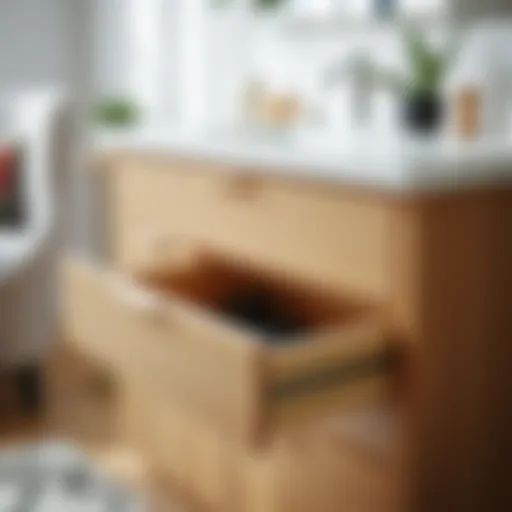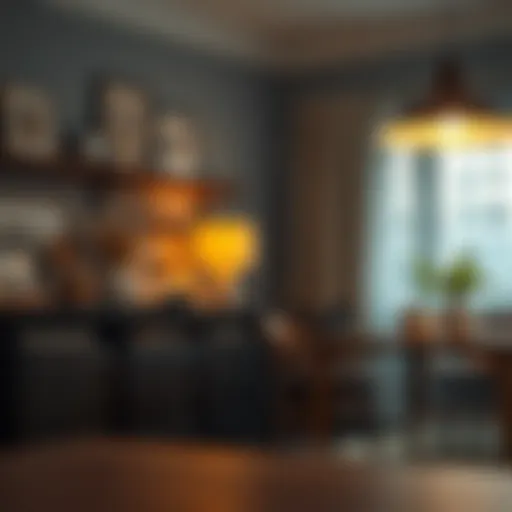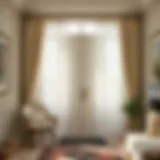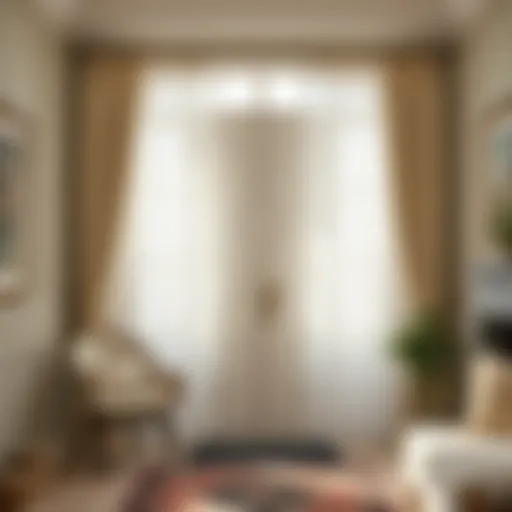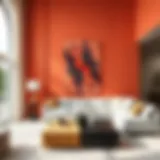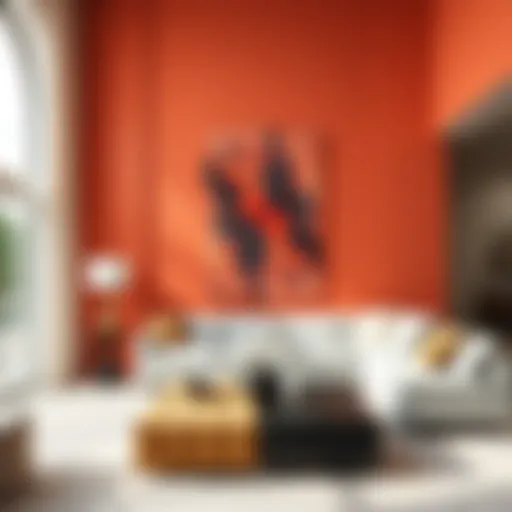Queen Anne Slipcovers: History, Design, and Care
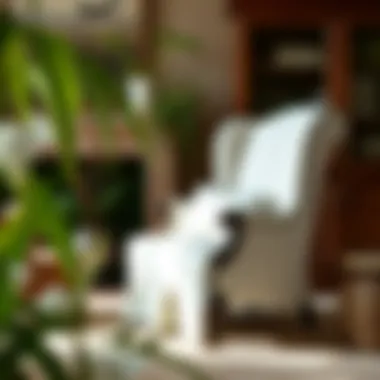
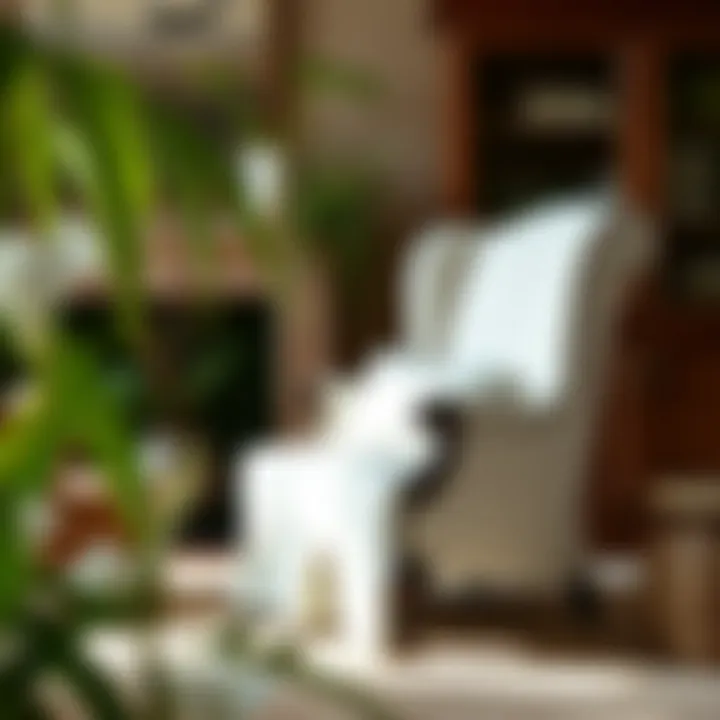
Intro
Queen Anne slipcovers exude a unique charm, embodying a style that reflects both elegance and practicality. The historical roots are deeply entwined with the Queen Anne furniture style which emerged in the early 18th century. This furniture was characterized by its graceful curves and intricate details, offering a distinct look that many homeowners adore today. But modern times call for flexibility and function; this is where slipcovers step in, allowing you to preserve the beauty of your antique pieces while adapting to current trends.
In the context of home decor, slipcovers serve not just as a protective layer against wear and tear, but they are also a way to refresh or entirely transform the aesthetic of a room. Whether you're hosting a gathering or just lounging at home, a well-fitted slipcover can elevate your comfort and style.
While the craftsmanship behind making these slipcovers can be complex, the result is undeniably rewarding. For those delving into the world of interior design or DIY undertakings, understanding the nuances of Queen Anne slipcovers is essential. In this guide, we will explore everything from historical significance and design features to practical advice on fabric selection and customization. Through this examination, you’ll discover how Queen Anne slipcovers not only enhance the visual appeal of your furniture but also contribute to a cozy and inviting ambiance in your home.
Understanding Queen Anne Slipcovers
Queen Anne slipcovers bring a distinct personality to the world of upholstery. They bridge the gap between aesthetics and practicality, making them an appealing choice for diverse audiences ranging from homeowners to interior designers. Understanding these slipcovers means diving into not just their visual charm but also their roots and functionalities.
These slipcovers are more than mere fabric drapes. They tell a story, reflecting historical tastes and design philosophies. Knowing their background can help one appreciate the elegance they embody in modern spaces. Moreover, they are coveted for their versatility; with a thoughtfully chosen slipcover, a piece of furniture can be transformed, breathing new life into even the most mundane room.
The beauty of Queen Anne slipcovers lies in their carefully tailored fit that reflects the curvilinear shapes typical of Queen Anne furniture. The emphasis isn’t solely on looks. The slipcovers serve as functional guards against wear and tear, providing a layer of protection for valuable furniture. When it comes to maintenance, caring for these covers can dramatically extend the life of the underlying piece, a rather significant aspect for those looking at both immediate and long-term investment.
"A well-fitted slipcover is like a tailored suit for your furniture: it enhances its features and provides protection."
Furthermore, the design characteristics are versatile enough to blend into various styles, whether one leans towards the rustic charm of a country cottage or the sleek lines of contemporary minimalism. Choosing Queen Anne slipcovers involves thoughtful consideration of motifs, colors, and fabric types, making it an engaging project for those who seek a personal touch in their decor.
In this guide, we will examine the origins of these slipcovers and their defining features. By grasping the historical context and design elements, one can better appreciate the significance of incorporating Queen Anne slipcovers into modern interior decor.
Material Considerations
When considering Queen Anne slipcovers, the choice of materials takes center stage. The fabric and other components determine not only the look but also the functionality and longevity of the slipcovers. This section will help to navigate the crucial elements of materials so that homeowners and designers can make informed choices, aligning their aesthetic desires with practical needs.
Fabric Types
The variety of fabrics available for Queen Anne slipcovers can be both a delight and a challenge. From cotton and linen to more luxurious options like silk and velvet, each fabric has its own set of characteristics. Here’s a look at some popular fabric types:
- Cotton: A go-to choice for its breathability and ease of care. It comes in various patterns and colors, making it a versatile option. However, it may wrinkle easily, requiring regular ironing.
- Linen: Known for its crisp finish and natural texture, linen gives a relaxed yet polished look. It can be a bit stiff, but over time, it softens beautifully. It's also absorbent, which is great for heat and spills.
- Polyester: A synthetic fabric that is gaining popularity for its durability and resistance to stains. Often blended with natural fibers to enhance its comfort, it is easy to clean, which suits families with kids or pets.
- Velvet: If you want to add a touch of luxury, velvet slipcovers are an excellent choice. They are soft and visually striking but require more attention in cleaning and maintenance.
- Canvas: Known for its durability, canvas can stand up to wear and tear while providing a refreshing look. It's great for high-traffic areas but might not be the softest option for lounging.
Choosing the right fabric is crucial—it affects how well the slipcover will fit, wear, and clean over time. Often, samples can provide insight into how a particular fabric will respond to daily use and cleaning methods.
Durability and Maintenance
When selecting slipcovers, durability and maintenance are pivotal. A stunning slipcover is of little use if it wears out or becomes a burden to maintain.
Durability Factors
- Weave: A tighter weave generally means enhanced durability. It’s less likely to fray or tear. Check the fabric's thread count—the higher the count, the tougher the material tends to be.
- Finish: Fabrics with special finishes can resist stains and fading, allowing them to maintain their charm over time.
Maintenance Considerations
Here are some tips on keeping your slipcovers in tip-top shape:
- Washing: Follow the care instructions provided with the fabric. Many slipcovers are machine washable. However, some fabrics may require dry cleaning, which can be costly.
- Spot Cleaning: For spills, a quick response is often the best. Blot—do not rub—and use a mild detergent solution if necessary.
- Sunlight Protection: Direct sunlight can fade fabrics. Consider rotating your slipcovers or using UV-protective window treatments to prolong their vibrancy.
Proper maintenance not only ensures the aesthetic appeal of Queen Anne slipcovers but also extends their lifespan, making them a sound investment for your home.
In summary, understanding the diverse fabric options and maintaining them properly will significantly influence the satisfaction and longevity of your Queen Anne slipcovers. Making deliberate choices based on style, durability, and the practicality of care can lead to a transformative impact in your living spaces.
Customizing Your Slipcovers
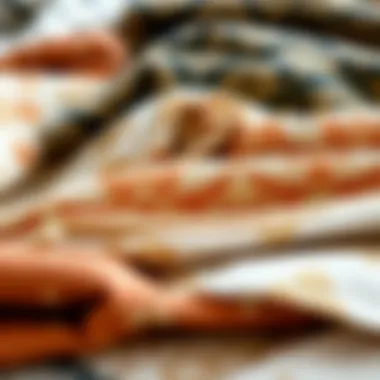
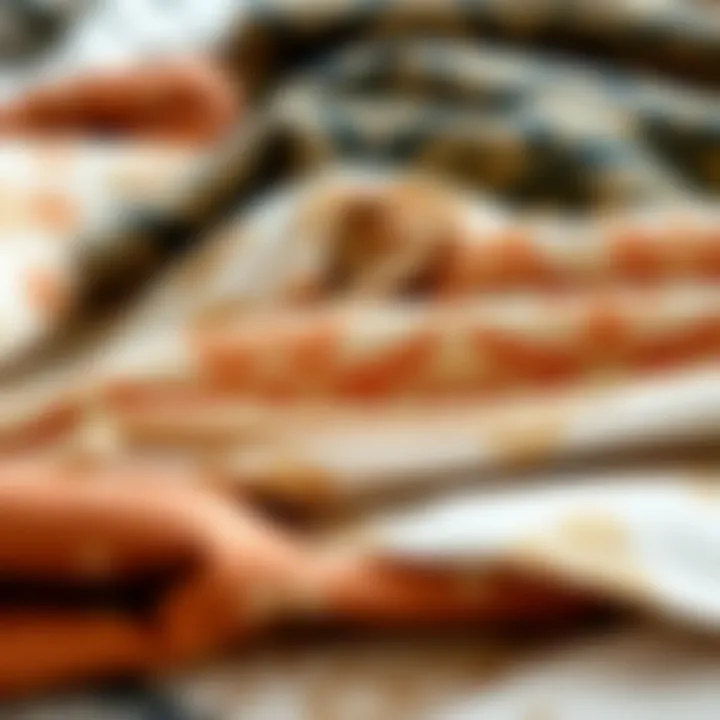
Customizing your Queen Anne slipcovers is more than just a personal choice; it's an opportunity to transform your furniture into a unique reflection of your personal style. In the realm of home decor, where trends seem to shift like sand, slipcovers offer the perfect blend of flexibility and creativity. For homeowners and designers alike, customizing allows you to tailor the furniture’s look and feel to fit any occasion or season, ensuring your living space remains both functional and stylish.
When you take the time to customize, you gain more than just aesthetic appeal. Custom slipcovers enhance the longevity of your furniture by shielding it from wear and tear. As the saying goes, a stitch in time saves nine; investing in quality fabrics and tailoring can spare you the headache of early replacements. Moreover, the thoughtfulness you put into selecting colors and patterns can amplify the overall mood of your room, catering to your tastes or the vibe you want to cultivate.
Tailoring Options
The world of tailoring options for slipcovers is expansive, providing various pathways to achieve a comfortable and polished look. At the heart of tailoring is the precise fit—the difference between a well-fitted slipcover and an ill-fitted one is akin to night and day. There are several approaches to consider:
- Custom Measurements: The foundational step in tailoring is to take meticulous measurements of your furniture. A properly tailored slipcover should hug the contours without being overly tight or baggy.
- Style Selection: When deciding how to tailor, think about whether you prefer a relaxed fit, which gives off a casual and inviting vibe, or a more structured style for a refined appearance. The choice of style will significantly influence the overall look of your space.
- Fabric Weight: Heavier fabrics might require more precise tailoring to maintain a clean line, while lighter materials can lend themselves to a more forgiving fit.
- Skirt Options: Consider how you'd like your slipcover to finish at the bottom. A tailored skirt can add sophistication, whereas a simple straight or pleated finish can feel more laid-back and friendly.
Adding Personal Touches
Personal touches can truly make your slipcovers one-of-a-kind. This is where your individual flair gets to shine through. Think about adding elements that speak to your personality or enhance the existing decor of your room. Here are several ideas:
- Pillows and Cushions: Don’t shy away from coordinating throw pillows. These can add bursts of color or pattern that link the slipcovers to the broader decor.
- Trim and Embellishments: Sometimes, a simple touch of piping or fringe at the edges can add that little extra oomph to your cover. It’s like putting on jewelry to complete an outfit.
- Color Palettes: When choosing colors, consider how they resonate with your space and mood. Soft neutrals can be calming, while bold hues could invigorate the area.
- Seasonal Changes: Why not consider a seasonal approach? You can design a set of slipcovers that you switch out depending on the time of year, allowing for fresh updates without overhauling your entire living space.
Customization isn’t just a trend; it’s a way to create comfort that reflects who you are and invites others to feel at home.
By embracing the customization of Queen Anne slipcovers, you're not only enhancing the functionality of your furniture but also affirming your identity within your living space. Each choice, from fabric to embellishment, converges to create a look that speaks loudly of your taste and thoughtfulness.
Practical Applications
The significance of practical applications regarding Queen Anne slipcovers cannot be overstated. These slipcovers aren’t merely decorative; they play a pivotal role in enhancing the functionality and aesthetic appeal of a variety of living spaces. Through thoughtful application, they offer solutions tailored to the unique needs of homeowners, renters, designers, and even DIY enthusiasts, allowing for a blend of beauty and practicality.
Enhancing Living Spaces
Queen Anne slipcovers serve as a versatile tool for transforming spaces within a home. When you think of enhancing living spaces, consider how these slipcovers can breathe new life into tired or mismatched furniture. A beautifully designed slipcover tailored for a Queen Anne chair can add a sophisticated flair, complement your decor, and even unify contrasting colors throughout a room.
A few benefits of using slipcovers in living spaces include:
- Protection: They protect upholstered furniture from spills, stains, and wear, acting as a shield while maintaining style.
- Flexibility: Slipcovers allow for quick changes to the look of a room, making it easy to refresh your decor without a complete overhaul.
- Cost-Effective: Investing in slipcovers is often more economical than reupholstering furniture or buying new pieces.
For instance, a family with young children may appreciate a fun, durable fabric that withstands daily wear while also looking sharp and inviting. Likewise, those preparing for a festive occasion can switch to luxurious fabrics, such as linen or velvet, to set the mood for celebration.
Seasonal Styles
Changing seasons often invite a desire for new looks, and Queen Anne slipcovers can help facilitate that transition with ease. Each season brings unique themes and colors—think pastel colors in spring and warm earth tones in fall.
Use slipcovers to embrace these seasonal styles by:
- Rotating Fabrics: Choose lighter fabrics during warmer months to keep your space feeling fresh and airy. Cotton and linen blends might be perfect for summer. When it comes to winter, richer fabrics, like heavy tapestry or thick cotton, cocoon your home in comfort while adding a touch of warmth.
- Incorporating Patterns: Seasonal motifs can be incorporated into slipcovers. Floral patterns work beautifully for spring, while plaid or winter-themed designs can make for cozy vibes during the colder months.
- Color Palettes: Transform the mood of a room with color. Light blues and soft yellows can suggest a bright spring atmosphere, whereas deep reds or forest greens in winter can create a warm and cozy retreat.
"Slipcovers are, in many ways, the chameleons of interior design—easily adapting to the seasons, needs, and tastes of the user."
This ability to navigate various uses makes them invaluable in any stylistic toolkit.
Sustainability Aspects
The increasing focus on sustainability in today’s world has seeped into various areas of design and home décor, and Queen Anne slipcovers are no exception. Their ecological implications are significant, influencing both the selection of materials and broader sourcing practices. As homeowners, renters, designers, and DIY enthusiasts aim to create stylish, yet environmentally conscious living spaces, understanding sustainability aspects becomes paramount.
One of the specific benefits of embracing eco-friendly practices in slipcover production is the reduction of waste. Traditional upholstery can be a cumbersome process involving numerous steps, often resulting in significant off-cuts and waste materials. In contrast, slipcovers made from sustainable fabrics can drastically lessen this impact, allowing for repurposed or minimal waste from the outset. Moreover, choosing organic textiles contributes to soil health and reduces chemical runoff, benefitting both the environment and the community.
Choosing sustainable options also speaks volumes about personal values and social responsibility. It’s an opportunity for individual expression without compromising the welfare of the planet. Knowledge of sustainability aspects enables designers and homeowners to make informed choices that resonate with their beliefs about environmental stewardship and ethical consumption.
Eco-Friendly Materials
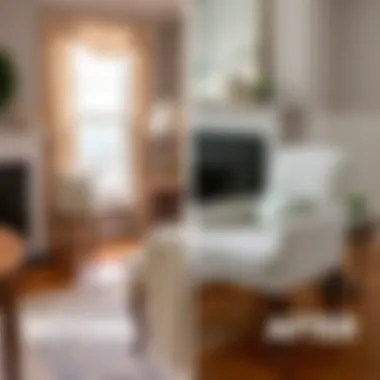
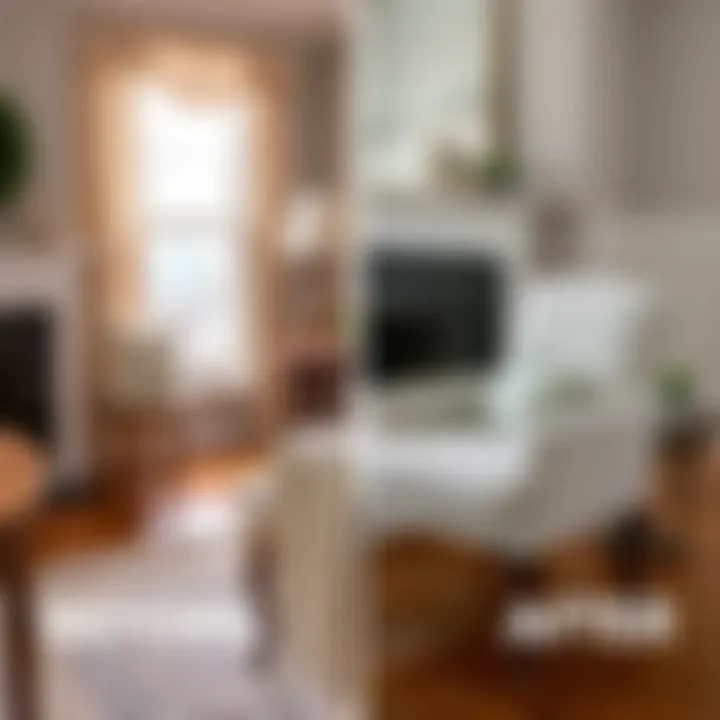
When diving into the realm of Queen Anne slipcovers, one cannot overlook the materials used in their crafting. Eco-friendly materials extend beyond the fashionable aesthetic; they embody a commitment to sustainable living. For instance, fabrics such as organic cotton, linen, and hemp stand out due to their minimal environmental impact during production.
- Organic Cotton: Grown without harmful pesticides, organic cotton is not only gentle on the planet but also offers a soft feel, making it ideal for slipcovers.
- Linen: Known for its durability, linen requires less water compared to conventional cotton, and its natural texture enhances the elegant charm associated with Queen Anne style.
- Hemp: A powerhouse in sustainability, hemp grows rapidly with little resource consumption. Its fibers are robust, promising long-lasting slipcovers.
Utilizing these materials contributes to a circular economy by lowering our carbon footprint and embracing renewable resources. When done right, these choices not only result in aesthetically pleasing outcomes but also showcase an individual’s inclination towards causing minimal harm.
Ethical Sourcing
In addition to using eco-friendly materials, ethical sourcing plays a critical role in fostering sustainable slipcover production. This means not just looking at whether the materials are environmentally friendly, but also considering how they are produced. Ethical sourcing focuses on fair labor practices and transparency within supply chains.
By opting for materials sourced from companies that prioritize worker rights and sustainable agricultural practices, designers can ensure that the beauty of their Queen Anne slipcovers is not tainted by exploitation. For instance,
- Supporting brands that participates in fair trade can help sustain livelihoods for communities while maintaining quality.
- Additionally, sourcing from local vendors reduces transportation emissions and supports the local economy.
These practices pave the way for a new generation of designers and consumers who value integrity as much as aesthetics. A commitment to ethical sourcing not only enhances the quality of the slipcovers but also aligns with a broader movement that prioritizes both people and the planet.
A conscientious choice in fabric and sourcing reflects in your home as a haven of not just style, but also of moral integrity and environmental respect.
In summary, sustainability is more than a buzzword in the context of Queen Anne slipcovers. It’s a call to action that marries design with ecological and social responsibility. By embracing eco-friendly materials and ethical sourcing, one can enjoy the beauty of these slipcovers while championing a more sustainable future.
Care and Maintenance
Taking care of Queen Anne slipcovers is crucial to preserving their beauty and functionality. Proper maintenance not only extends the lifespan of the fabric, but it also ensures that the aesthetic appeal of the furniture remains intact. Given the investment often associated with custom slipcovers, neglect can lead to wear and discoloration that diminishes their overall charm.
The benefits of regular care include not only improved appearance but also cleanliness and hygiene. Slipcovers can collect dust, pet hair, and allergens over time, making routine attention important, especially in homes with pets or young children. A little bit of effort goes a long way toward keeping your slipcovers looking their best, thereby enhancing your living space.
Cleaning Recommendations
Maintaining cleanliness for your Queen Anne slipcovers is not as daunting as it may seem. It’s essential to follow a few guidelines to keep the fabric fresh and in good condition. Here are some recommendations:
- Check the Care Label: Every slipcover comes with a care label. Understanding specific cleaning instructions is vital, as different fabrics may have unique needs.
- Regular Vacuuming: Use a vacuum attachment to remove dust and debris weekly. This simple task prevents buildup that can damage the fibers over time.
- Spot Cleaning: For minor stains, a soft cloth or sponge with mild detergent can work wonders. Blot, don’t rub, to avoid damaging the fabric.
- Machine Washing: If the care label permits it, most slipcovers can be machine washed on a gentle cycle. Ensure you use cold water to prevent shrinking.
- Air Drying: After washing, it's best to air dry the slipcovers. Heat can warp the fabric, so hanging them in a shaded area helps maintain their shape.
- Professional Cleaning: For tougher stains or delicate fabrics, consider professional cleaning services. They have the expertise to tackle deep-rooted issues without compromising the fabric.
"Regular attention to slipcovers can prevent costly replacements and enhance the life of your furniture."
Storage Solutions
When slipcovers are not in use, proper storage is key to keeping them in excellent condition. Following a few simple storage tips can prevent creasing, fading, and other forms of damage:
- Clean Before Storing: Always clean slipcovers before storing them. Even minor stains can set in over time, making them harder to remove later.
- Use Breathable Bags: Opt for breathable cotton or linen storage bags. Plastic can trap moisture, leading to mildew or unpleasant odors.
- Fold Neatly: Fold slipcovers gently to avoid creases. Avoid putting heavy items on top, as this can distort their shape.
- Avoid Sunlight Exposure: Store them in a dark, cool place to prevent sunlight from causing fading and discoloration.
- Check Regularly: Periodically inspect stored slipcovers for any signs of mold or pests. Catching these issues early can save a lot of hassle later on.
By integrating these maintenance and storage tips into your routine, you’ll ensure that your Queen Anne slipcovers remain a source of pride and beauty in your home for years to come.
For additional information on fabric care, consider reviewing resources at The Fabric Care Council or read Wikipedia's guide on textile care.
Whether you are a homeowner looking to maintain the aesthetic of your living room or a designer focusing on functionality and style, understanding care and maintenance for Queen Anne slipcovers is a step toward maximizing your investment.
Case Studies and Inspirations
The exploration of Queen Anne slipcovers extends beyond mere aesthetics; it serves as a look into applications that resonate with both residential and commercial settings. Understanding real-life implementations can inspire homeowners, designers, and DIY enthusiasts alike. Here, we delve into specific case studies and inspirations that reflect the versatility and charm of these slipcovers. These examples highlight their functional benefits, creative potential, and adaptable nature across various contexts.
Residential Examples
In a cozy suburban home, a living room once adorned with bulky leather sofas transformed dramatically with the addition of rich, patterned Queen Anne slipcovers. The new fabric was not only visually striking but also offered a protective layer that preserved the underlying furniture against wear and tear. The homeowner remarked that the slipcovers made her space feel alive, allowing her to mix and match according to season or occasion.
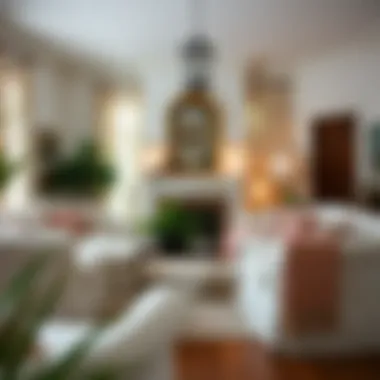
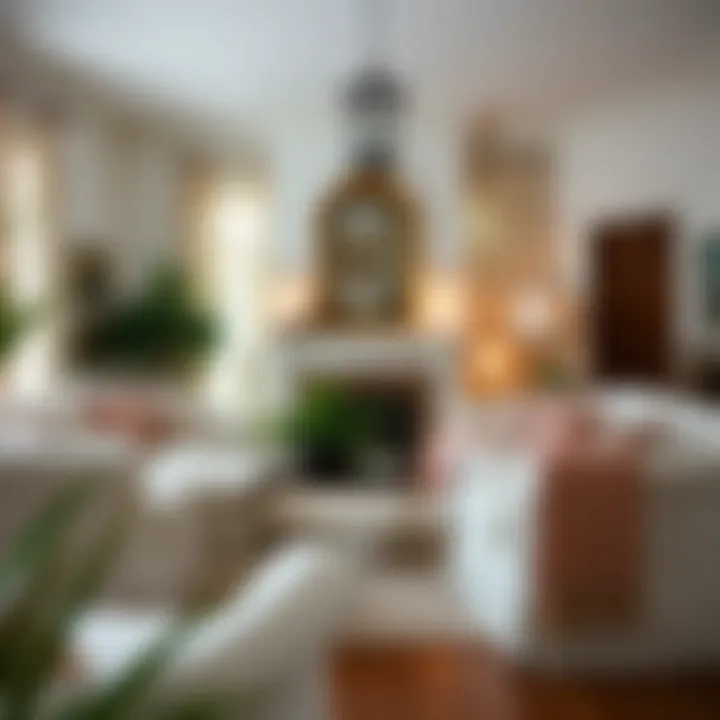
- Color Palette: The use of muted earthy tones during winter made the room feel warm and inviting, while bright florals in spring added a refreshing touch.
- Protection: The slipcovers safeguarded the original upholstery, making cleaning easier without sacrificing style.
Another standout example can be found in a historic townhouse, where traditional charm meets modern living. Here, slipcovers were custom-tailored for Queen Anne chairs, embodying a sense of continuity with the home’s history while offering practical updates.
"Slipcovers breathed fresh life into my grandmother’s chairs, allowing us to enjoy their heritage while making them fit our lifestyle," shared the homeowner, who opted for durable fabric with a classic damask print.
Commercial Applications
Commercial spaces also reap significant advantages from incorporating Queen Anne slipcovers. Take a boutique hotel that was looking to create a comfortable, inviting atmosphere for its guests. They introduced slipcovers in their lounge area, opting for luxurious fabrics that complemented their décor while providing a casual elegance.
- Cost-effective Redesign: Instead of purchasing new furniture, slipcovers allowed for a refresh of existing pieces, saving on costs without compromising quality or aesthetics.
- Brand Identity: Tailored slipcovers reflected the hotel's commitment to comfort and style, becoming a conversation starter among patrons.
In a bustling café, Queen Anne slipcovers adorned the seating areas, offering a balance of comfort and whimsy. By using vibrant patterns, the café not only ensured a unique ambiance but also catered to the casual nature of cafe culture.
- Easy Maintenance: With high foot traffic, the removable and washable slipcovers proved practical, allowing easy upkeep for staff.
- Seasonal Flair: The café switched out slipcovers seasonally, keeping the environment fresh and appealing to repeat customers.
These case studies highlight the wide-ranging applications of Queen Anne slipcovers, showcasing their ability to blend functionality with style. Through these real-life examples, it becomes evident how slipcovers offer creative solutions for enhancing spaces, fostering a sense of individuality and character. Whether in the comfort of a private home or the vibrancy of a commercial setting, they stand as a testament to timeless design and practicality.
Future of Slipcovers in Interior Design
The landscape of interior design is always evolving, and slipcovers are carving out a substantial spot in this ongoing transformation. As homeowners seek to balance aesthetics with practicality, Queen Anne slipcovers have emerged not just as a fad, but as a lasting solution that aligns with contemporary needs. This section will explore the significance of these cozy, adaptable coverings while delving into why they might just be the unsung heroes of home decor in the years to come.
Emerging Trends
As we look to the future, several trends are surfacing in the world of slipcovers, particularly Queen Anne styles. One fascinating trend is the movement towards sustainable materials. Manufacturers are increasingly shifting focus to organic fabrics, such as hemp and organic cotton. The allure of these materials extends beyond their eco-friendliness. They also offer durability and comfort, ensuring that the integrity of the slipcover holds up over time.
Another notable trend is the inclination towards bold prints and textures. Homeowners are now daring to step outside the box with their choices. From striking geometric designs to artisanal, hand-painted patterns, these slipcovers add character to otherwise conventional furniture. The goal? To create a visual statement that reflects personal style while maintaining functionality.
"There's a renaissance happening with fabrics that not only cover furniture but also tell a story and evoke feelings."
Additionally, modular slipcovers are gaining popularity, highlighting versatility. These designs allow individuals to mix and match elements for a personalized touch. As a result, homeowners can transform the look of their living spaces with minimal effort, making it an attractive option for those who often change their decor to stay current or simply for seasonal updates.
Influence of Technology
Technology is now more ingrained in every facet of life, and the world of slipcovers is no different. Innovations in fabric technology are revolutionizing the types of materials that can be used for Queen Anne slipcovers. For example, manufacturers are producing stain-resistant fabrics that repel spills and dirt, ensuring ease of maintenance. This takes one common worry off the plate of homeowners who might be hesitant about using lighter-colored fabrics.
Moreover, advancements in digital printing technology mean that intricate designs can be printed directly onto fabrics with precision. This capability enables designers to create unique patterns that were once thought impractical, catering to diverse aesthetic preferences. Whether it’s a soft floral or an abstract splash of color, the possibilities are nearly endless.
On a more functional note, augmented reality (AR) is starting to play a role in the shopping experience for slipcovers. Through AR apps, users can see how different slipcovers will look on their furniture before making a purchase. This technology empowers homeowners, allowing them to have confidence in their selections and ensuring a seamless fit with their existing decor.
As we move into a future where balance between style and practicality is crucial, Queen Anne slipcovers stand out as a solution that embraces changing needs and preferences. They can adapt elegantly and serve functional purposes without sacrificing beauty. The evolution of both design trends and technology promises a vibrant future for slipcovers in interior design.
The End
As we draw the curtain on our exploration of Queen Anne slipcovers, it’s clear that these covers do more than just protect your furniture; they carry with them a story steeped in history while offering a high degree of customization. This article highlights the significance of understanding both the aesthetic and functional properties of these slipcovers, ultimately illuminating their multifaceted benefits.
Reflecting on Benefits
Queen Anne slipcovers provide a harmonious blend of style and function that caters to a broad audience, from homeowners wanting to refresh their decor to designers seeking unique pieces. By investing in these slipcovers, one not only enhances the visual appeal of an interior space but also retains the original character of the furniture beneath. The key benefits include:
- Versatility: Suitable for various styles and themes, these slipcovers can transform a heavily patterned chair into a minimalist focal point with just a change of fabric.
- Protection: They shield your upholstery from stains and wear, prolonging the lifespan of your investment.
- Easy Maintenance: Machine-washable fabrics make upkeep a breeze, allowing one to keep their furniture looking sharp without a hassle.
In essence, shifting towards slipcovers can be a game changer for those looking to revamp their spaces while being pragmatic about furniture care.
Encouragement for Exploration
Delving into the realm of Queen Anne slipcovers isn’t just about following trends; it’s an invitation to express individuality through decor. Whether you’re thrifting a vintage piece or commissioning a custom cover, the options are practically limitless. Embrace this journey—experiment with textures, play with patterns, and layer different materials to derive designs that resonate with your personal style.
Moreover, connect with local artisans or explore platforms like Etsy to find unique offerings tailored specifically to your needs. For those who might be inclined towards DIY, there are ample resources available to guide the ambitious into creating a personal masterpiece.
In short, there’s a wealth of inspiration waiting just around the corner, inviting you to embark on an adventure that combines creativity with practicality. Let Queen Anne slipcovers be the canvas of your next home decor project, adding charm, comfort, and chic to your living spaces.



